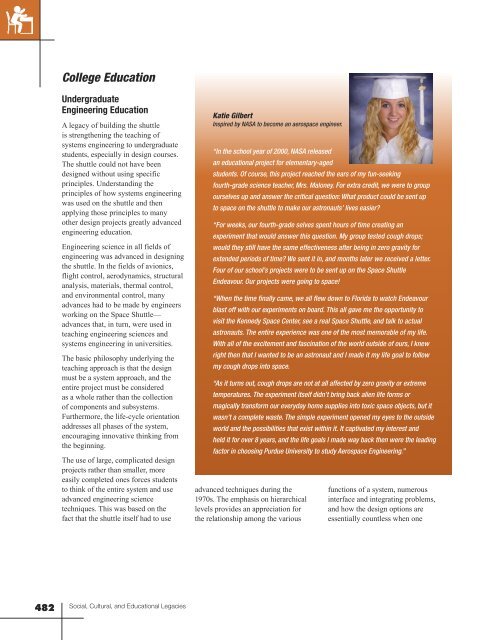Social, Cultural and Educational Legacies - ER - NASA
Social, Cultural and Educational Legacies - ER - NASA
Social, Cultural and Educational Legacies - ER - NASA
Create successful ePaper yourself
Turn your PDF publications into a flip-book with our unique Google optimized e-Paper software.
College EducationUndergraduateEngineering EducationA legacy of building the shuttleis strengthening the teaching ofsystems engineering to undergraduatestudents, especially in design courses.The shuttle could not have beendesigned without using specificprinciples. Underst<strong>and</strong>ing theprinciples of how systems engineeringwas used on the shuttle <strong>and</strong> thenapplying those principles to manyother design projects greatly advancedengineering education.Engineering science in all fields ofengineering was advanced in designingthe shuttle. In the fields of avionics,flight control, aerodynamics, structuralanalysis, materials, thermal control,<strong>and</strong> environmental control, manyadvances had to be made by engineersworking on the Space Shuttle—advances that, in turn, were used inteaching engineering sciences <strong>and</strong>systems engineering in universities.The basic philosophy underlying theteaching approach is that the designmust be a system approach, <strong>and</strong> theentire project must be consideredas a whole rather than the collectionof components <strong>and</strong> subsystems.Furthermore, the life-cycle orientationaddresses all phases of the system,encouraging innovative thinking fromthe beginning.The use of large, complicated designprojects rather than smaller, moreeasily completed ones forces studentsto think of the entire system <strong>and</strong> useadvanced engineering sciencetechniques. This was based on thefact that the shuttle itself had to useKatie GilbertInspired by <strong>NASA</strong> to become an aerospace engineer.“In the school year of 2000, <strong>NASA</strong> releasedan educational project for elementary-agedstudents. Of course, this project reached the ears of my fun-seekingfourth-grade science teacher, Mrs. Maloney. For extra credit, we were to groupourselves up <strong>and</strong> answer the critical question: What product could be sent upto space on the shuttle to make our astronauts’ lives easier?“For weeks, our fourth-grade selves spent hours of time creating anexperiment that would answer this question. My group tested cough drops;would they still have the same effectiveness after being in zero gravity forextended periods of time? We sent it in, <strong>and</strong> months later we received a letter.Four of our school’s projects were to be sent up on the Space ShuttleEndeavour. Our projects were going to space!“When the time finally came, we all flew down to Florida to watch Endeavourblast off with our experiments on board. This all gave me the opportunity tovisit the Kennedy Space Center, see a real Space Shuttle, <strong>and</strong> talk to actualastronauts. The entire experience was one of the most memorable of my life.With all of the excitement <strong>and</strong> fascination of the world outside of ours, I knewright then that I wanted to be an astronaut <strong>and</strong> I made it my life goal to followmy cough drops into space.“As it turns out, cough drops are not at all affected by zero gravity or extremetemperatures. The experiment itself didn’t bring back alien life forms ormagically transform our everyday home supplies into toxic space objects, but itwasn’t a complete waste. The simple experiment opened my eyes to the outsideworld <strong>and</strong> the possibilities that exist within it. It captivated my interest <strong>and</strong>held it for over 8 years, <strong>and</strong> the life goals I made way back then were the leadingfactor in choosing Purdue University to study Aerospace Engineering.”advanced techniques during the1970s. The emphasis on hierarchicallevels provides an appreciation forthe relationship among the variousfunctions of a system, numerousinterface <strong>and</strong> integrating problems,<strong>and</strong> how the design options areessentially countless when one482<strong>Social</strong>, <strong>Cultural</strong>, <strong>and</strong> <strong>Educational</strong> <strong>Legacies</strong>
















